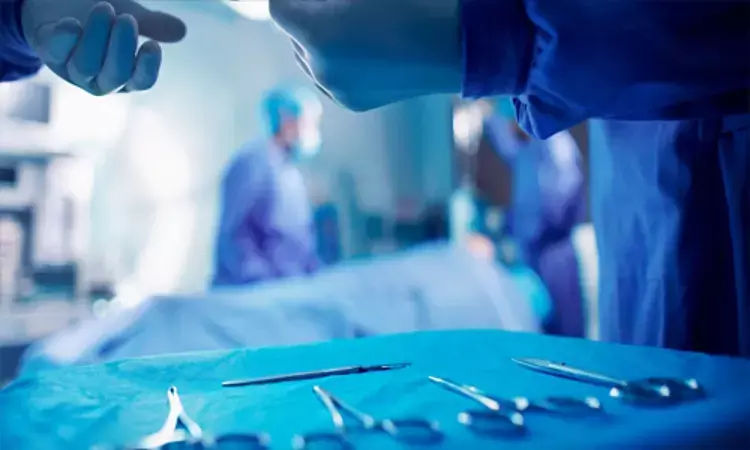- Home
- Medical news & Guidelines
- Anesthesiology
- Cardiology and CTVS
- Critical Care
- Dentistry
- Dermatology
- Diabetes and Endocrinology
- ENT
- Gastroenterology
- Medicine
- Nephrology
- Neurology
- Obstretics-Gynaecology
- Oncology
- Ophthalmology
- Orthopaedics
- Pediatrics-Neonatology
- Psychiatry
- Pulmonology
- Radiology
- Surgery
- Urology
- Laboratory Medicine
- Diet
- Nursing
- Paramedical
- Physiotherapy
- Health news
- Fact Check
- Bone Health Fact Check
- Brain Health Fact Check
- Cancer Related Fact Check
- Child Care Fact Check
- Dental and oral health fact check
- Diabetes and metabolic health fact check
- Diet and Nutrition Fact Check
- Eye and ENT Care Fact Check
- Fitness fact check
- Gut health fact check
- Heart health fact check
- Kidney health fact check
- Medical education fact check
- Men's health fact check
- Respiratory fact check
- Skin and hair care fact check
- Vaccine and Immunization fact check
- Women's health fact check
- AYUSH
- State News
- Andaman and Nicobar Islands
- Andhra Pradesh
- Arunachal Pradesh
- Assam
- Bihar
- Chandigarh
- Chattisgarh
- Dadra and Nagar Haveli
- Daman and Diu
- Delhi
- Goa
- Gujarat
- Haryana
- Himachal Pradesh
- Jammu & Kashmir
- Jharkhand
- Karnataka
- Kerala
- Ladakh
- Lakshadweep
- Madhya Pradesh
- Maharashtra
- Manipur
- Meghalaya
- Mizoram
- Nagaland
- Odisha
- Puducherry
- Punjab
- Rajasthan
- Sikkim
- Tamil Nadu
- Telangana
- Tripura
- Uttar Pradesh
- Uttrakhand
- West Bengal
- Medical Education
- Industry
Combined division of splenic vein non inferior to separate division In distal pancreatectomy: JAMA

A recent study has demonstrated that in distal pancreatectomy, the combined division of the splenic vein is non inferior compared with separate division of the splenic vein regarding safety. Thus, isolating the splenic vein from the pancreatic parenchyma is deemed unnecessary, the research team suggested.
In distal pancreatectomy (DP), the splenic vein is isolated from the pancreatic parenchyma prior to being ligated and divided to prevent intra-abdominal hemorrhage from the splenic vein stump with pancreatic fistula (PF). Conversely, dissecting the splenic vein with the pancreatic parenchyma is easy and time-saving.
With this background, researchers aimed to establish the safety of combined division of the splenic vein compared with separate division of the splenic vein.
This study was designed as a multicenter prospective randomized phase 3 trial. All results were analyzed using the modified intent-to-treat set. Patients undergoing DP for pancreatic body and tail tumors were eligible for inclusion. Patients were randomly assigned between August 10, 2016, and July 30, 2019. Patients were centrally randomized (1:1) to either separate division of the splenic vein or combined division of the splenic vein. The primary end point was the incidence of grade B/C PF, and the incidence of intra-abdominal hemorrhage was included as one of the secondary end points.
Data analysis revealed the following facts.
- A total of 318 patients were randomly assigned, and 2 patients were excluded as ineligible. Of the 316 remaining patients, 150 (50.3%) were male.
- The modified intent-to-treat population constituted 159 patients (50.3%) in the separate division group and 157 patients (49.7%) in the combined division group. In the modified intent-to-treat set, the proportion of grade B/C PF in the separate division group was 27.1% (42 of 155) vs 28.6% (44 of 154) in the combined division group (adjusted odds ratio, 1.108; 95% CI, 0.847-1.225; P = .047), demonstrating noninferiority of the combined division of the splenic vein against separate division.
- The incidence of postoperative intra-abdominal hemorrhage in the 2 groups was identical at 1.3%."In conclusion, the multicenter COSMOS-DP trial successfully demonstrated the noninferiority of combined division of the splenic vein compared with separate division of the splenic vein in terms of the incidence of grade B/C PF. Thus, the safety of this procedure was established such that it could be recommended with more confidence."the team concluded.
For full article follow the link: doi:10.1001/jamasurg.2021.0108
Primary source:JAMA Surgery
Dr Satabdi Saha (BDS, MDS) is a practicing pediatric dentist with a keen interest in new medical researches and updates. She has completed her BDS from North Bengal Dental College ,Darjeeling. Then she went on to secure an ALL INDIA NEET PG rank and completed her MDS from the first dental college in the country – Dr R. Ahmed Dental College and Hospital. She is currently attached to The Marwari Relief Society Hospital as a consultant along with private practice of 2 years. She has published scientific papers in national and international journals. Her strong passion of sharing knowledge with the medical fraternity has motivated her to be a part of Medical Dialogues.
Dr Kamal Kant Kohli-MBBS, DTCD- a chest specialist with more than 30 years of practice and a flair for writing clinical articles, Dr Kamal Kant Kohli joined Medical Dialogues as a Chief Editor of Medical News. Besides writing articles, as an editor, he proofreads and verifies all the medical content published on Medical Dialogues including those coming from journals, studies,medical conferences,guidelines etc. Email: drkohli@medicaldialogues.in. Contact no. 011-43720751


